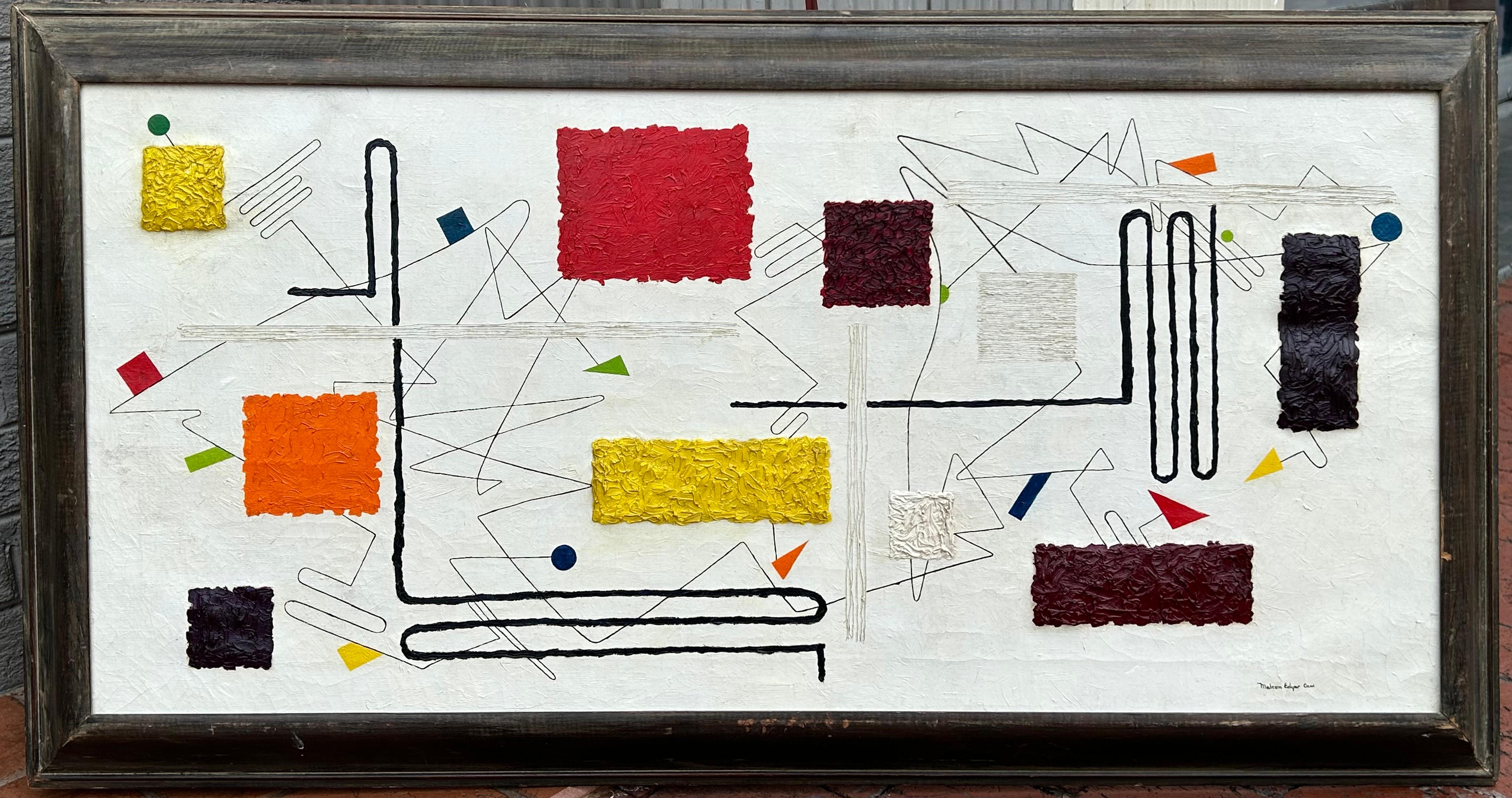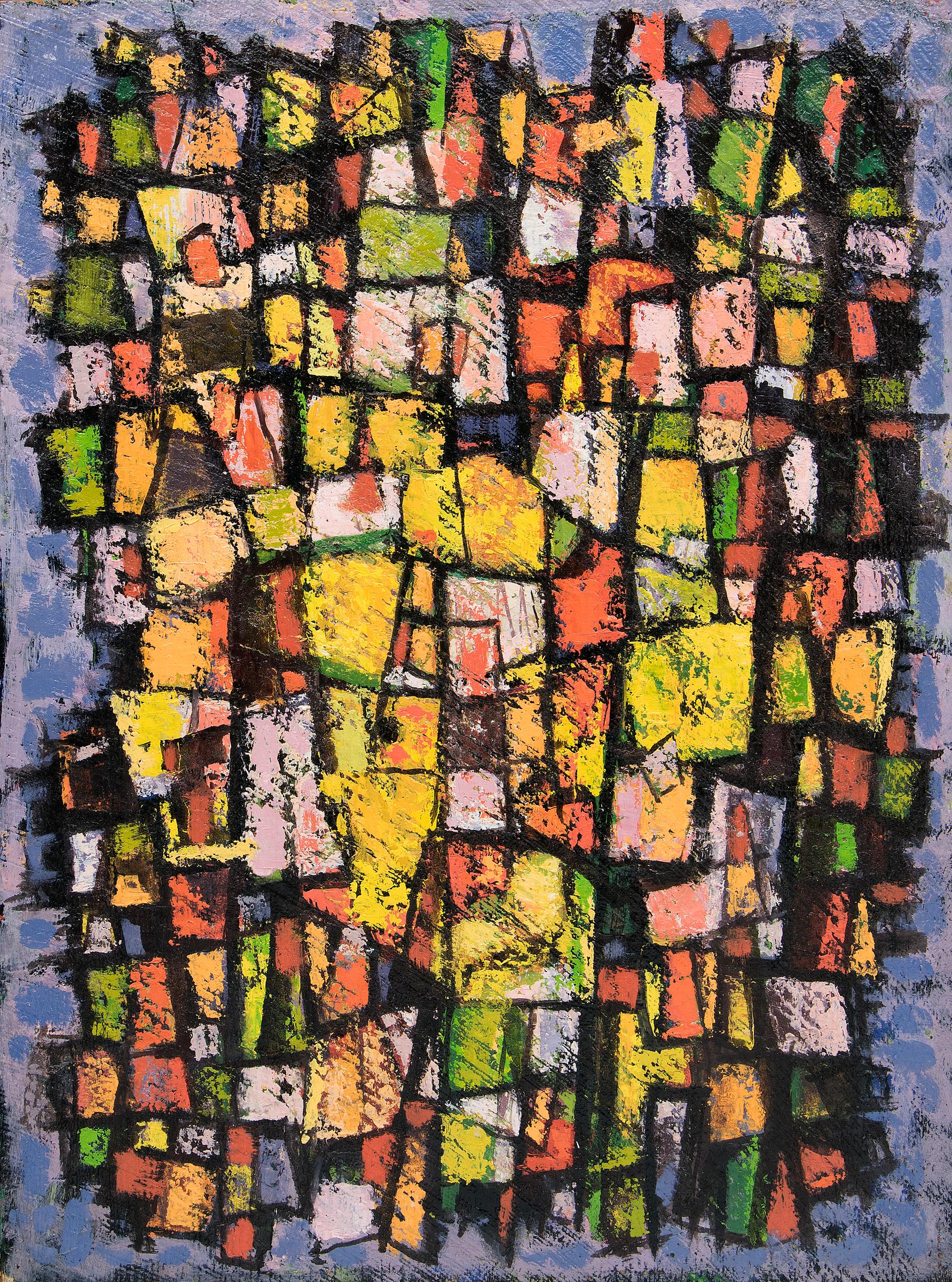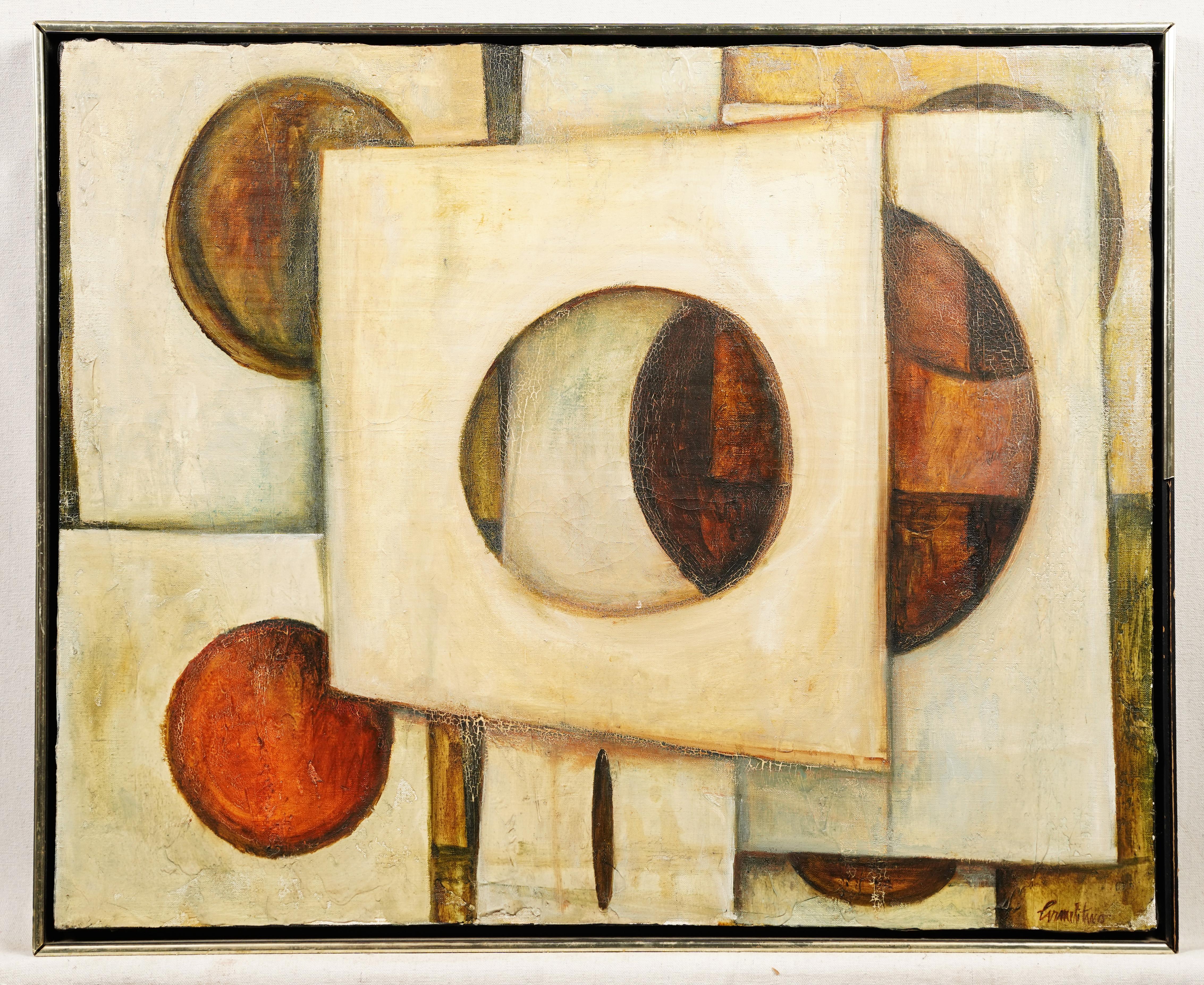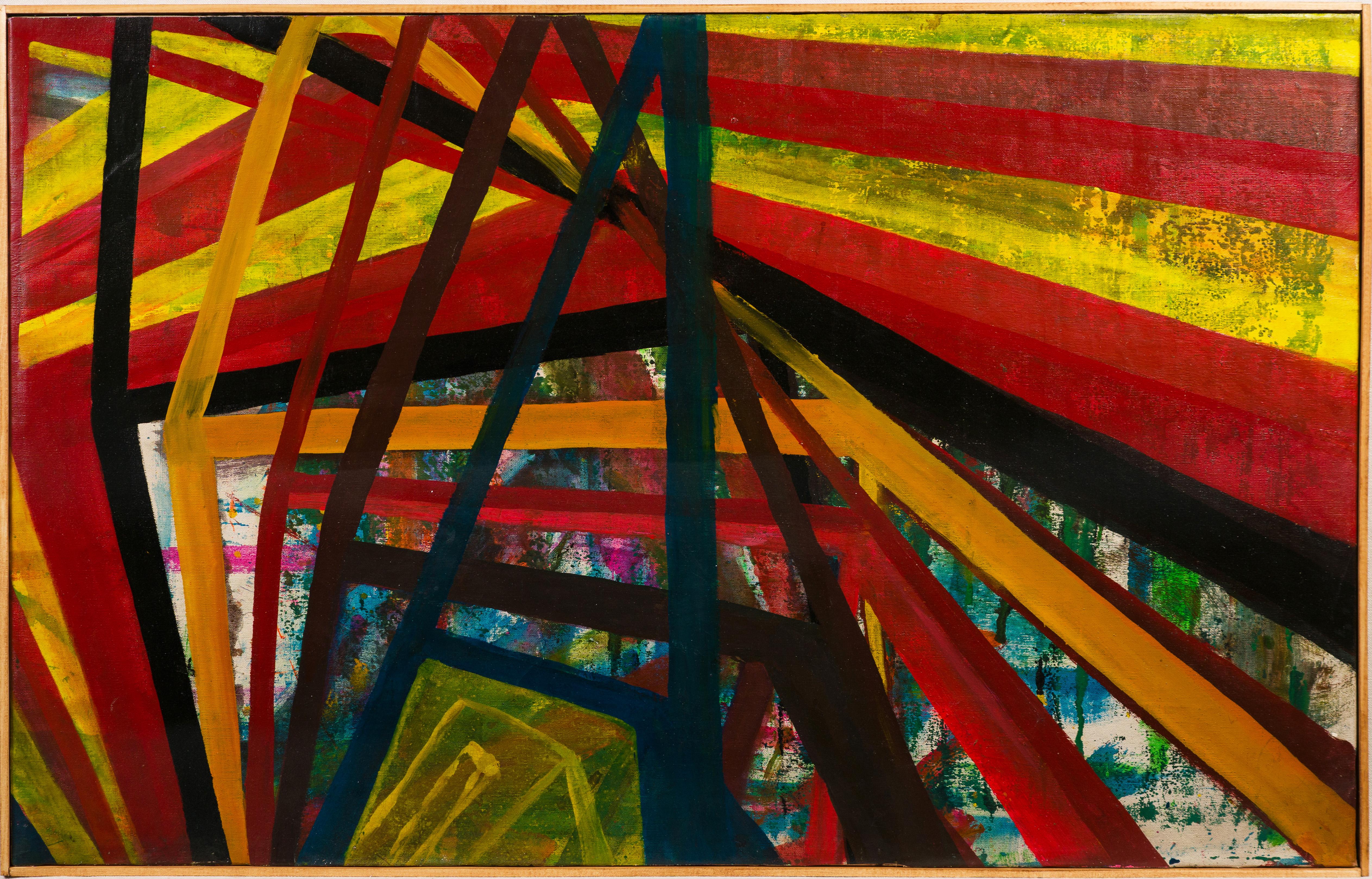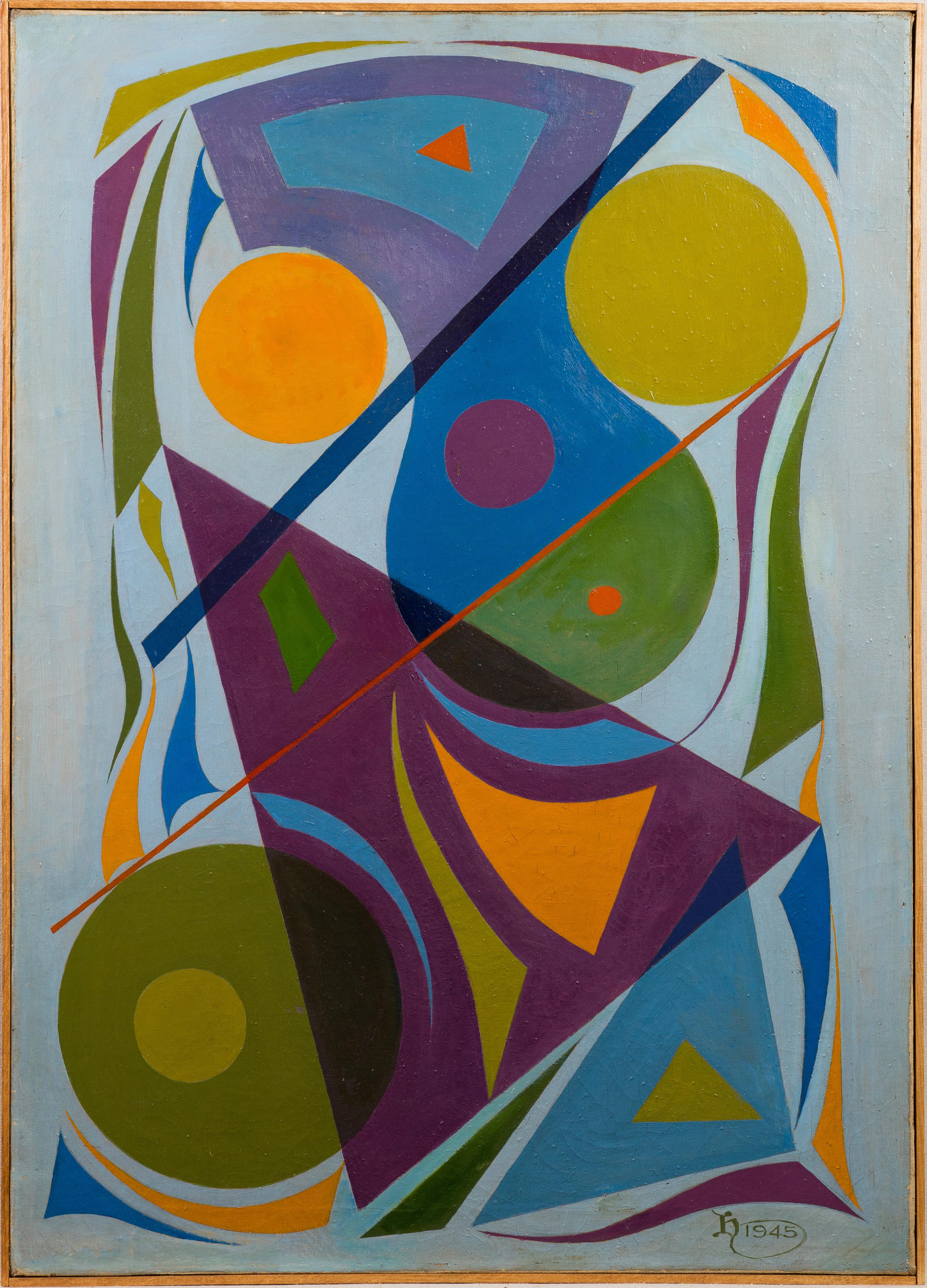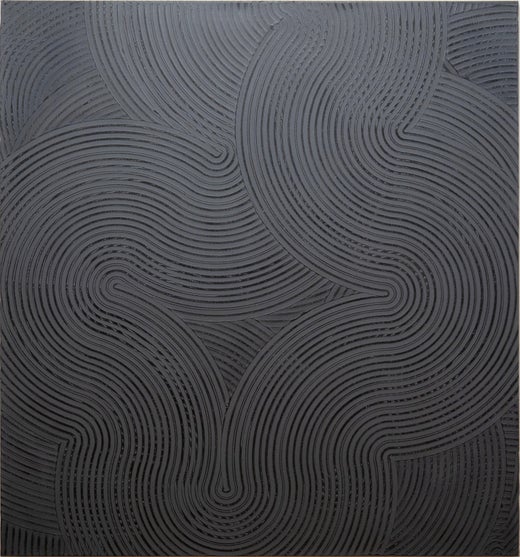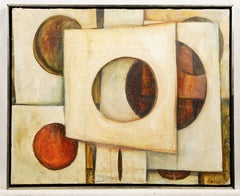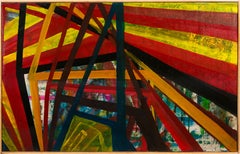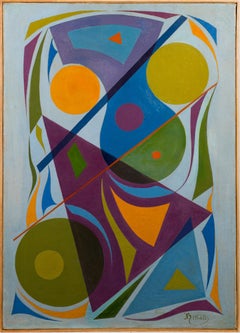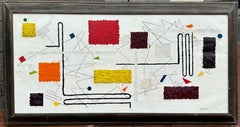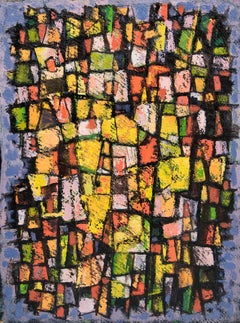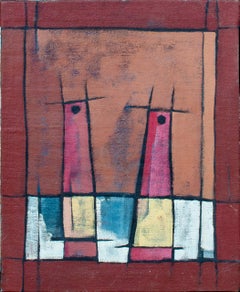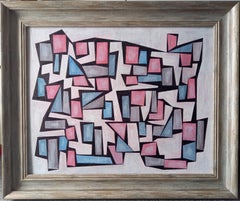Items Similar to Geometric Abstract Oil Painting Duanye Hatchett Original Modernist Early Work
Want more images or videos?
Request additional images or videos from the seller
1 of 9
Duanye HatchettGeometric Abstract Oil Painting Duanye Hatchett Original Modernist Early Work1994
1994
$2,240
$2,99525% Off
£1,697.22
£2,269.2825% Off
€1,947.43
€2,603.8225% Off
CA$3,152.04
CA$4,214.4525% Off
A$3,464.96
A$4,632.8425% Off
CHF 1,821.02
CHF 2,434.8125% Off
MX$42,077.24
MX$56,259.5325% Off
NOK 22,716.82
NOK 30,373.6125% Off
SEK 21,522.59
SEK 28,776.8625% Off
DKK 14,534.17
DKK 19,432.9625% Off
About the Item
An abstract painting by Duayne Hatchett from his Trowel Painting Series. Oil on canvas, circa 1990. Signed. Framed.
Duayne Hatchett was a visual artist whose work included prints, paintings, sculpture, and found objects. He was born on May 12, 1925 in Shawnee, Oklahoma. He enlisted in the Air Force where he trained to become a fighter pilot. After leaving the militrary he studied design at the University of Oklahoma. His highly technical military training combined a mathematical intelligence with a love for physics and a daring embrace of new experience, all of which would soon be the tools for his evolution through art.
Two major influences interacted on his early development at OU. Emelio Omero, a colleague and close friend of Diego Rivera, introduced him to the revolutionary art ideas of Mexico City, while teaching him a wide range of printing techniques that would culminate in a Masters Degree in Painting in 1952. During this time he met Bruce Goff, a renowned Wright disciple, who was teaching architecture at OU and befriended Hatchett, introducing him to the most avant-garde architecture of that time.
He spent his summers while at OU designing for a small sign shop, which introduced him to new materials used for building neon, plastic, and metal signs. The use of new materials and a keen sense for design would soon become invaluable building blocks for future sculpture. During this time he met and married Mary Ellen Jeffries. They would spend their lives together and raise three children, David (me), my brother Dana, and my sister Jeffri. As children, they were immersed in art from childhood and benefited greatly from this loving art and domestic environment.
Hatchett was always interested in the techniques of construction, often watching different tradesmen working, understanding how materials are put together to create the manmade environment that surrounded him. While teaching printmaking at Oklahoma City University from 1951 through ‘54, he began to build sculpture employing some of the materials and techniques that he saw workers using. He was beginning to draw the attention of architects and he became interested in their work-trade processes, moving from blue prints to construction. He accepted an invitation from Alexander Hogue to teach sculpture at Tulsa University in 1954. He moved his family to Tulsa where he would teach for the next ten years.
While in Tulsa, he became well known as a teacher and a sculptor, often lecturing at various sculpture conferences around the country. He also began to obtain commissions for sculpture as his interaction with architecture continued to evolve. He began to meet and interact with some of the most influential New York artists, including David Smith, Louise Nevelson, Noguchi, and Chicago artist, Richard Hunt.
The 'found object' became important subject matter for many artists including Hatchett and his frequent trips to junkyards yielded the materials for welded sculptures that explored abstract forms suggestive of the world around him. Sources of inspiration ranged from a dead cat smashed on the road to Sputnik orbiting the earth. Alan Stone Gallery in New York City, arranged to show two of these pieces at the Museum of Modern Art in 1963.
He was offered a teaching job at Ohio State University in 1964, where he would teach sculpture for the next three years, and make a leap of imagination that would propel his art into the museums and galleries in New York City and beyond. He began by moving away from combining found objects to using found materials to fabricate objects that he called "Totems." Royal Marks Gallery in New York City began to represent Hatchett in 1964 and arranged for him to be included in the ‘Young American Sculpture East to West’ show representing the United States in the 1964 New York World’s Fair. He would then leave any hint of the found object or junk material behind (until the 90’s) and move into pure abstraction, what can only be described as 'Modern' Art.
Taking his cue from modern architecture, he began to draw simplified volumes and planes, minimally rendered, so as to be easily grasped as a whole. Built with industrial materials, sheet metals and plastics, the images suggested the look of modern technology and architectural accuracy in the environment. These new works resulted in multiple one-person shows, including shows at Royal Marks Gallery in 1965, ’68, ’69, and ’70, and defined a major shift in his work that would be played out for the next two decades. He was featured on the cover of the Whitney Annual and the Whitney Museum acquired a large sculpture in 1967. He was included in the American Sculpture of the Sixties show at the Los Angeles County Museum and the Pittsburgh International, at the Carnegie Institute Museum of Art that same year.
In 1968 he took a teaching position at the University of Buffalo where he would head the sculpture department for the next 24 years and he would move his art in multiple directions. He began a series of paintings to exploit the simple line drawings previously used to define the plate metal sculpture. These paintings explored the optical relativity of two and three-dimensional space depicted on a flat plane. He was also continuing to develop his geometric minimalist sculptures, landing several sculpture commissions around the country. In 1974, the Albright-Knox Art Gallery in Buffalo, NY presented, Duayne Hatchett: Recent Paintings and Sculpture. In the ensuing years his work would be shown in one person and group shows around the country. In the studio, the confluence of construction and the 'Found Object' re-entered his work in a completely unexpected way. Construction itself became the creative engine transforming his new art.
New tools and working processes were adopted or invented to create new art. The trowel would replace the brush for building new paintings. Tools for rolling and burnishing metal would be invented and riveting would be adopted to build new sculptures. He was influenced by the characteristics of materials and objects such as corrugated sheet metals, the optical effects of plastics, metal grates, tin cans, seen in his man made environment, as well as crosscut tree logs and drift wood from his natural environment. He began to build sculptures, in the privacy of his studio, largely unseen by the public.
In the late 90’s, the found object re-emerged in the form of new sculpture created from railroad spikes welded together to form organic conglomerations reminiscent of nature. He also began to build assemblages of found objects and materials that maintained a continuous flat surface, which were simultaneously sculptures as well as being blocks for prints. By utilizing a wide range of printing techniques that he invented, he made mono-prints that record the image of the assembled material constructions, greatly extending his previous uses of the found object, and greatly expanding the imagery in his printmaking.
From printmaking and painting of the late 40’s, influenced by Mexican Art, through the junk metal used from found objects in the 50’s and early 60’s, through the minimalist sculpture and paintings influenced by modern architecture from the 60’s and 70’s, to the paintings, sculpture and printmaking of the last forty years, Duayne Hatchett has developed a personal expression that solicits a universal response. His unique visual language has been created through the invention of tools, the manipulation of various materials and objects, which he presents in a unified form. These expressions reflect our environment, specifically and generally, as objects once in use or patterns at play. Hatchett’s art works are interactive vessels that hold their content as potential energy, waiting to unlock our memories and our senses through the act of observation.
–David Hatchett, March 2009
Duayne passed away on September 7, 2015.
- Creator:Duanye Hatchett (1925 - 2015, American)
- Creation Year:1994
- Dimensions:Height: 18 in (45.72 cm)Width: 23 in (58.42 cm)Depth: 1 in (2.54 cm)
- Medium:
- Movement & Style:
- Period:
- Condition:
- Gallery Location:Buffalo, NY
- Reference Number:1stDibs: LU13929506492
Duanye Hatchett
Duayne Hatchett was a visual artist whose work included prints, paintings, sculpture, and found objects. He was born on May 12, 1925 in Shawnee, Oklahoma. He enlisted in the Air Force where he trained to become a fighter pilot. After leaving the military he studied design at the University of Oklahoma. His highly technical military training combined a mathematical intelligence with a love for physics and a daring embrace of new experience, all of which would soon be the tools for his evolution through art. He accepted an invitation from Alexander Hogue to teach sculpture at Tulsa University in 1954. He moved his family to Tulsa where he would teach for the next ten years. While in Tulsa, he became well known as a teacher and a sculptor, often lecturing at various sculpture conferences around the country. He also began to obtain commissions for sculpture as his interaction with architecture continued to evolve. He began to meet and interact with some of the most influential New York artists, including David Smith, Louise Nevelson, Noguchi, and Chicago artist, Richard Hunt. In 1968 he took a teaching position at the University of Buffalo where he would head the sculpture department for the next 24 years and he would move his art in multiple directions. He began a series of paintings to exploit the simple line drawings previously used to define the plate metal sculpture. These paintings explored the optical relativity of two and three-dimensional space depicted on a flat plane. He was also continuing to develop his geometric minimalist sculptures, landing several sculpture commissions around the country. In 1974, the Albright-Knox Art Gallery in Buffalo, NY presented, Duayne Hatchett: Recent Paintings and Sculpture. In the ensuing years his work would be shown in one person and group shows around the country. In the studio, the confluence of construction and the 'Found Object' re-entered his work in a completely unexpected way. Construction itself became the creative engine transforming his new art. New tools and working processes were adopted or invented to create new art. The trowel would replace the brush for building new paintings. Tools for rolling and burnishing metal would be invented and riveting would be adopted to build new sculptures. He was influenced by the characteristics of materials and objects such as corrugated sheet metals, the optical effects of plastics, metal grates, tin cans, seen in his man made environment, as well as crosscut tree logs and drift wood from his natural environment. He began to build sculptures, in the privacy of his studio, largely unseen by the public. In the late 90’s, the found object re-emerged in the form of new sculpture created from railroad spikes welded together to form organic conglomerations reminiscent of nature. He also began to build assemblages of found objects and materials that maintained a continuous flat surface, which were simultaneously sculptures as well as being blocks for prints.
About the Seller
4.9
Gold Seller
Premium sellers maintaining a 4.3+ rating and 24-hour response times
Established in 1970
1stDibs seller since 2015
3,047 sales on 1stDibs
Typical response time: 4 hours
- ShippingRetrieving quote...Shipping from: Brooklyn, NY
- Return Policy
Authenticity Guarantee
In the unlikely event there’s an issue with an item’s authenticity, contact us within 1 year for a full refund. DetailsMoney-Back Guarantee
If your item is not as described, is damaged in transit, or does not arrive, contact us within 7 days for a full refund. Details24-Hour Cancellation
You have a 24-hour grace period in which to reconsider your purchase, with no questions asked.Vetted Professional Sellers
Our world-class sellers must adhere to strict standards for service and quality, maintaining the integrity of our listings.Price-Match Guarantee
If you find that a seller listed the same item for a lower price elsewhere, we’ll match it.Trusted Global Delivery
Our best-in-class carrier network provides specialized shipping options worldwide, including custom delivery.More From This Seller
View AllAntique American Modernist Geometric Abstract Framed Oil Painting
Located in Buffalo, NY
Nicely painted American school abstract geometric oil painting in a period frame. Signed lower right "Flemming" but without an artist determined.
Category
1960s Abstract Abstract Paintings
Materials
Canvas, Oil
$1,020 Sale Price
20% Off
Antique American School Modernist Abstract Framed Geometric Oil Painting
Located in Buffalo, NY
Antique American modernist abstract oil painting. Oil on canvas. Framed. Image size, 30L x 24H.
Category
1950s Abstract Landscape Paintings
Materials
Canvas, Oil
$1,036 Sale Price
20% Off
Mid Century Modern New York Geometric Abstract Framed Oil Painting
Located in Buffalo, NY
Antique American modernist abstract oil painting. Oil on canvas. Framed.
Category
1960s Abstract Abstract Paintings
Materials
Canvas, Oil
$396 Sale Price
20% Off
Important Early American School Abstract Geometric Precisionist Signed Painting
Located in Buffalo, NY
Step into the enigmatic world of abstract art with this captivating original oil painting from 1945. This masterpiece, signed with a mysterious monogram by an unknown artist, embodie...
Category
1940s Abstract Abstract Paintings
Materials
Canvas, Oil
$1,996 Sale Price
20% Off
Abstract American Geometric Oil Painting Martin Rosenthal 60 Mid Century Modern
By Martin Rosenthal
Located in Buffalo, NY
An original abstract oil painting by American artist Martin Rosenthal signed by the artist and created in the late 1950's, early 1960's.
This colorful dynamic work comes housed in a...
Category
1960s Abstract Geometric Abstract Paintings
Materials
Paper, Oil
Vintage American Modernist Abstract Minimalist New York School Oil Painting
By Duanye Hatchett
Located in Buffalo, NY
Vintage American modernist abstract oil painting by Duayne Hatchett (1925 - 2015). Oil on board, circa 1994. Signed on verso. Displayed in a period modern frame. Image, 22"L x 24"H.
Category
1990s Abstract Abstract Paintings
Materials
Canvas, Oil
$2,380 Sale Price
20% Off
You May Also Like
Mid-Century Modern Abstract Oil Painting
Located in Fredericksburg, VA
Signed lower right. This Mid Century Modern artist, Malcom Edgar Case (1924-1984), is known for abstract figurative painting and clothing design. Th...
Category
Mid-20th Century Abstract Geometric Abstract Paintings
Materials
Canvas, Oil
1950s Original Geometric Abstract Oil Painting, Vertical & Horizontal Art
By Paul Kauvar Smith
Located in Denver, CO
This vibrant and dynamic original abstract oil painting by Paul Kauvar Smith (1893–1977) showcases the artist’s bold use of color and modernist technique. Executed in oil on board, t...
Category
1950s Abstract Geometric Abstract Paintings
Materials
Board, Oil
Midcentury Abstract Geometric Painting by Mystery artist
Located in New York, NY
Mystery Artist
Untitled, Mid-20th Century
Oil on canvas
12 x 9 3/4 x 1 3/4 in.
Category
Mid-20th Century Abstract Geometric Abstract Paintings
Materials
Canvas, Oil
Abstract II. Contemporary Abstract Oil Painting
By Christopher Barrow
Located in Brecon, Powys
Oil on board, well framed
Signed
Image 16" x 20"
Framed 20" x 24"
Category
2010s Abstract Abstract Paintings
Materials
Oil
Miles Cole, Squares in a Space, Abstract Geometric Painting, Contemporary Art
By Miles Cole
Located in Deddington, GB
Squares in a Space [2017]
Original
Abstract
Oil Paint on Canvas
Image size: H:46 cm x W:56 cm
Frame Size: H:50 cm x W:60 cm x D:4cm
Sold Framed
Please note that insitu images are pur...
Category
21st Century and Contemporary Abstract Abstract Paintings
Materials
Canvas, Oil
1991 Modern Vintage Swedish Geometric Abstract Tempera Painting - Interaction
Located in Bristol, GB
INTERACTION
Size: 64 x 76.5 cm (including frame)
Tempera on canvas
A vibrant geometric abstract composition that explores form and interaction, executed in tempera onto canvas and d...
Category
1990s Abstract Abstract Paintings
Materials
Canvas, Tempera
More Ways To Browse
Large Wood Sculpture And Totems
Vintage Found Object Sculpture
Engravings Of Rome
Two Lovers
Antique Ballet
Chagall I And The Village
Oil Painting Flower Dark Background
Peter Max Vintage
Black Couple
Photograph Black And White Brazil
Salvador Dali Signed Prints 1972
Uk Photography
3d Wall Sculpture
Black Woman Portrait Painting
Estes Richard
Gelatin Silver Print Of A Nude Woman
Kenya Art
Dutch Old Master Still Life Painting
